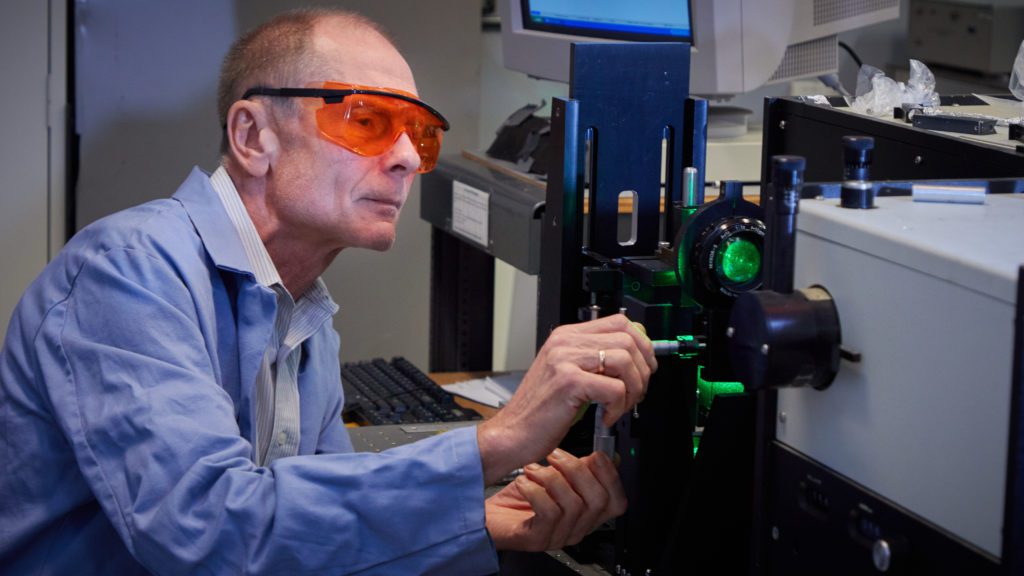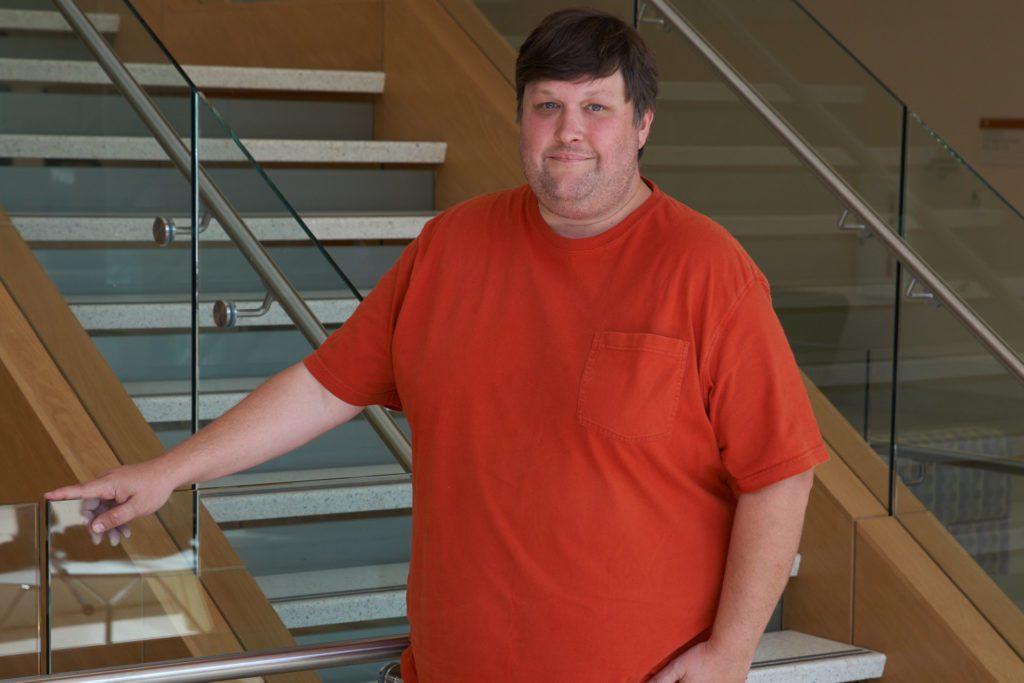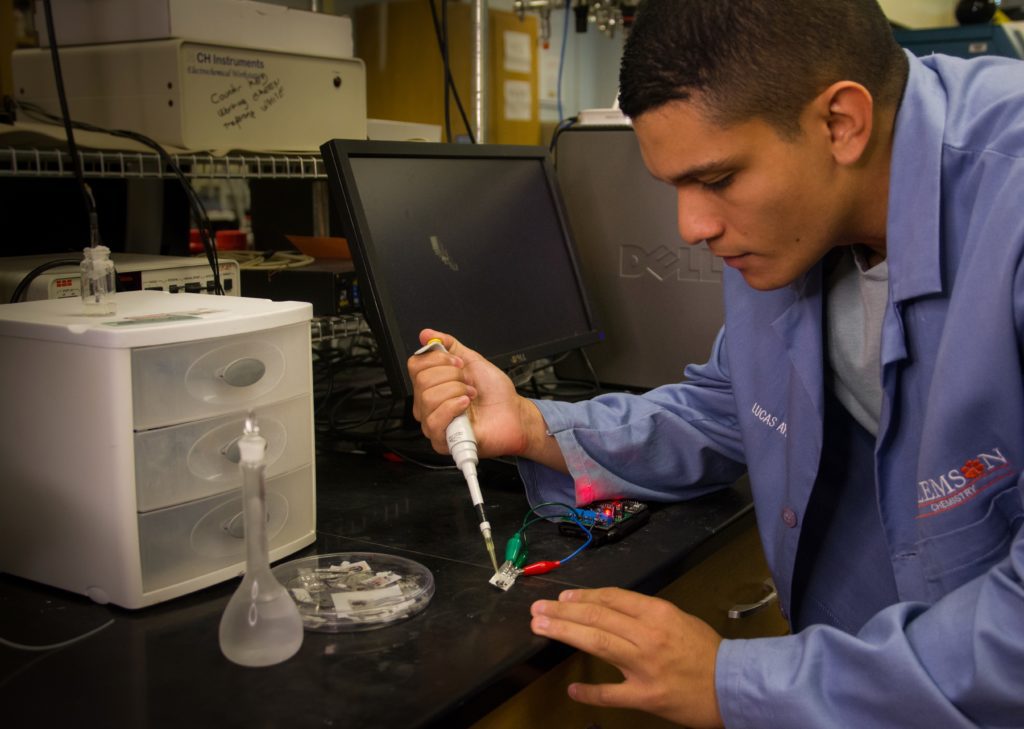Chemistry touches every aspect of everyday life, from the air we breathe and the food we eat to the cars we drive and the products we use.
This week is National Chemistry Week, an event sponsored by the American Chemical Society to highlight chemistry’s importance.
This year’s theme is “Fabulous Fibers: The Chemistry of Fabrics.” To celebrate, the Clemson University College of Science is spotlighting three faculty members whose research is linked to the use of various fibers.

Disappearing colors
Clemson Chemistry Professor George Chumanov and his colleagues turned into a detectives of sorts when an automobile upholstery manufacturing company asked for help. The cars’ seat fabric was suddenly starting to fade when the sun hit the cars parked on dealer lots.
“It’s all chemistry,” Chumanov said. “What happens when fabric fades is that the dye molecules decompose. The molecules fall apart, and the color disappears. Photobleaching happens every minute. You cannot prevent it. The question is how to minimize and control it.”
One of Chumanov’s areas of expertise is photophysics — the physics of light and its interaction with matter.

“It was immediately apparent to us that the problem had something to do with the manufacturing process, that they had inevitably changed something that ultimately led to the fabric being less stable,” he said.
Knowing the fundamentals of photodegradation is just the first step. “Translating those fundamentals into the real why is much more complex,” said Chumanov.
Besides sunlight, factors such as oxygen levels, moisture and temperature can affect the fabric and dye molecules.
Here, Chumanov’s lab, Department of Chemistry lecturer Rakesh Sachdeva and specialists from the manufacturing company used a variety of tools — including chemical, optical and mass spectrometry measurements — to reveal how properties of the dyes and fabrics had changed before and after the fading to pinpoint causes of the problem.
“I learned how to appreciate the complexity of real-world situations. It’s often extremely difficult to identify the problem under conditions where you don’t have full control of conditions,” said Chumanov, whose fabric research has also included creating clothing that repelled dirt and making yarns that can produce electricity when exposed to sunlight.
His current research involves the synthesis and investigation of high-end carbon nanofibers.

Removing pollutants
Thanks to its practicality, comfort and convenience, cotton is the most popular fabric in the world. But Daniel Whitehead, an associate professor in the Department of Chemistry, isn’t using it to make blue jeans or T-shirts. Instead, he is turning cotton fibers into nanoparticles that remove environmental pollutants.
Cotton is about 80 percent cellulose. Whitehead’s lab degrades the non-crystalline portion of the cotton fibers using a chemical reaction, leaving tiny cellulose nanocrystals. Between 1,000 and 1,600 of the nanocrystals would fit on the cross-section surface of a human hair.
A polymer placed on the surface of the nanocrystals reacts with the target contaminant.

Initially, the project targeted volatile compounds that caused odors during the fat-rendering process that separates protein from fat in leftover parts of animals we don’t eat for use in pet food. Researchers made a filter cartridge out of the nanoparticles and passed the air from the plant through the filter. They found the filter removed at least 95 percent of the odor molecules from the air.
Whitehead’s lab has also used the nanoparticles to degrade pesticides and remove polyfluorinated surfactants, a persistent environmental contaminant, from water. Scientists have also investigated using nanocrystals to remove metal contaminants from rendered fat so it can be refined into renewable fuel.
“What we like about cellulose nanocrystals is that they’re very cheap to make because they come from cotton, which is a commodity crop. They’re easy to chemically modify after we’ve synthesized them, and it gives us a nice biodegradable platform that we can use for these applications to remove contaminants from the environment,” Whitehead said. “We think it’s useful for a variety of applications.”
While the lab has showed that the material works in multiple applications at a lab scale, it must still prove it can work on an industrial scale for an affordable price.
“We’ve shown we can do this with 100 milliliters of fat. What happens if we try to do it with 1,000 pounds of fat? The question is, can we make it affordable enough that it can be applied in the market?” he said.

Wearable devices
When most people think of wearable devices, they probably think of smartwatches, fitness trackers and wearable monitors that collect information on physical activity, measure blood oxygen saturation levels, detect falls and even surveil heart rhythms.
Clemson Chemistry Professor Carlos Garcia’s lab is researching a different type of a wearable device that would use paper fibers (turned into carbon electrodes) to efficiently and inexpensively detect infections or even monitor cancer biomarkers to determine whether a treatment is working.
Wearable devices could give doctors the information they need to treat a problem.
“Most often, doctors make a diagnosis based on the best clinical data available,” Garcia said. “We want to provide more data so that diagnosis is more accurate and ultimately improve clinical outcomes.”

Using pyrolysis, the paper is heated in the absence of oxygen to temperatures high enough that the cellulose fibers turn to carbon while preserving the paper’s 3D structure.
“You end up with something that looks like spaghetti noodles, and each of the fibers can conduct electricity and become a chemical sensor,” Garcia said. “That gives us tremendous flexibility in the design of these sensors and allows us to measure things we could not measure with standard color-based devices.”
Previously, Garcia’s lab created sensors that measured metabolites, gases, heavy metals and even bleach.
However, two factors limited the applicability of this material in wearable applications — brittleness and some electrical resistance. But Lucas Ayres, a Ph.D. student in Garcia’s lab, used a natural polymer to coat the electrodes, making them flexible enough to withstand bending and added a thin layer of gold to improve the electron transfer process. In collaboration with Kristi Whitehead, a senior lecturer in the Department of Biological Sciences, they developed a device that can be attached to skin and detect the presence of Staphylococcus aureus, a commonly misdiagnosed and mistreated pathogen.
“Fundamentally, Lucas is addressing limitations that apply to many other carbon materials, enabling the development of other sensors. On the application side, this addresses a clinical need to have a way of diagnosing these infections using a system that is not invasive and inexpensive,” Garcia said.
The College of Science pursues excellence in scientific discovery, learning, and engagement that is both locally relevant and globally impactful. The life, physical and mathematical sciences converge to tackle some of tomorrow’s scientific challenges, and our faculty are preparing the next generation of leading scientists. The College of Science offers high-impact transformational experiences such as research, internships and study abroad to help prepare our graduates for top industries, graduate programs and health professions. clemson.edu/science
Get in touch and we will connect you with the author or another expert.
Or email us at news@clemson.edu
